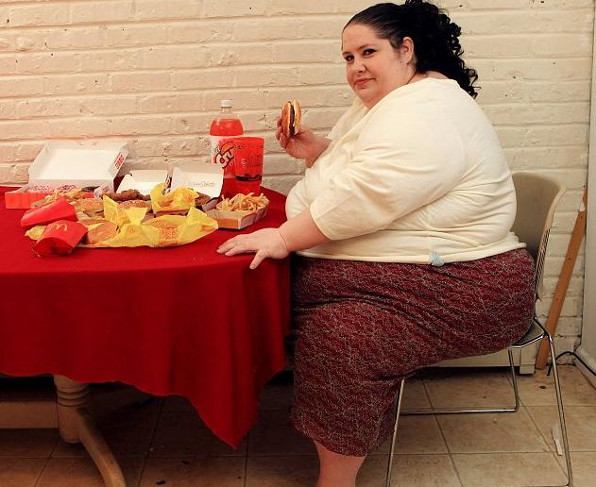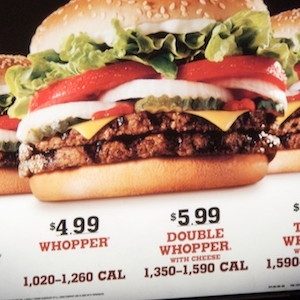You’ve probably heard the joke about a woman who tells a friend she’s on a new ‘Seafood’ diet but can’t seem to lose any weight. Oh? says the friend. “Yah. When I see Food, I eat it.” But it turns out that there may be some truth in that hoary jest. And researchers say the effect works directly on your brain…
 I wonder… Would Calorie count labeling do anything
I wonder… Would Calorie count labeling do anything
to dissuade her from overeating?
We all know that the sight of a beautifully-prepared and presented meal can make our mouths water and our stomachs growl for gratification. Chefs will tell you that the appearance of food is just as important – sometimes more so – than the aroma or flavour.
Now, researchers at Dartmouth College in Hanover, New Hampshire, say they’ve discovered that one specific aspect of how food is presented can directly effect how desirable we feel it is.
What they did…
Researchers recruited 42 undergraduate students (ages 18 to 22) to view 180 food images without calorie information followed by images with Calorie information and were asked to rate their desire to eat the food – while lying in a functional magnetic resonance imaging scanner (fMRI). The images were obtained from either the food pics database or popular, fast food restaurant websites that post calorie information. The 22 dieters and 20 non-dieters viewed the same set of images, including foods such as a Cheeseburger, a side of French Fries or a slice of Cherry Cheesecake. On a scale from 1 to 4 (1 = not at all, 4 = very much), they indicated how likely they would be to eat the food in the dining hall.
What they found…
Seeing pictures of food with Calorie information not only makes food less appetizing but it also appears to change the way your brain responds to the food, according to a new study. When food images appeared with the Calorie content, the brain showed decreased activation of the reward system and increased activation in the control system. In other words, foods that you might otherwise be inclined to eat became less desirable once the Calorie content was displayed.
The takeaway…
The study seems to support the principle behind the U.S. Food & Drug Administration’s recently enacted menu labeling law requiring the disclosure of calorie information on menus and menu boards at large restaurant chains.
“Our findings suggest that calorie-labeling may alter responses in the brain’s reward system when considering food options. Moreover, we believe that nutritional interventions are likely to be more successful if they take into account the motivation of the consumer, including whether or not they diet,” says Lead Author, then-grad student Andrea Courtney (now a postdoctoral student at the Stanford Social Neuroscience Lab at Stanford University).
My take…
I don’t know of anyone who doesn’t seriously consider the Calorie count of foods before committing to eat them, or deciding whether to have a larger or smaller portion. The word ‘Calorie’ has an almost magical ring to it that makes folks – whether they’re watching their weight or not – think twice before indulging. No Calorie count posted? ‘What you don’t know won’t make you fatter’, we tend to say. It’s human nature. And guilt about over-eating or eating fattening foods is at least as powerful a motivator as any subconscious factors science might identify. The average person doesn’t need a Calorie count to know that a Large order of Fries or a Double Burger is sinful.
~ Maggie J.

